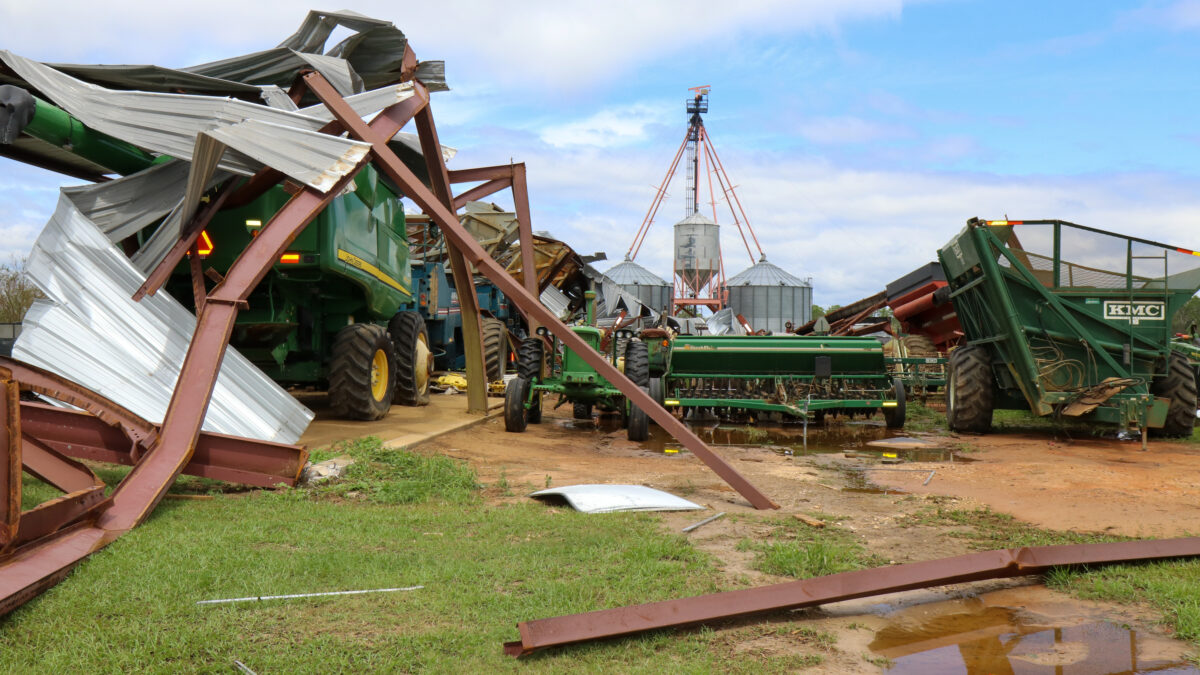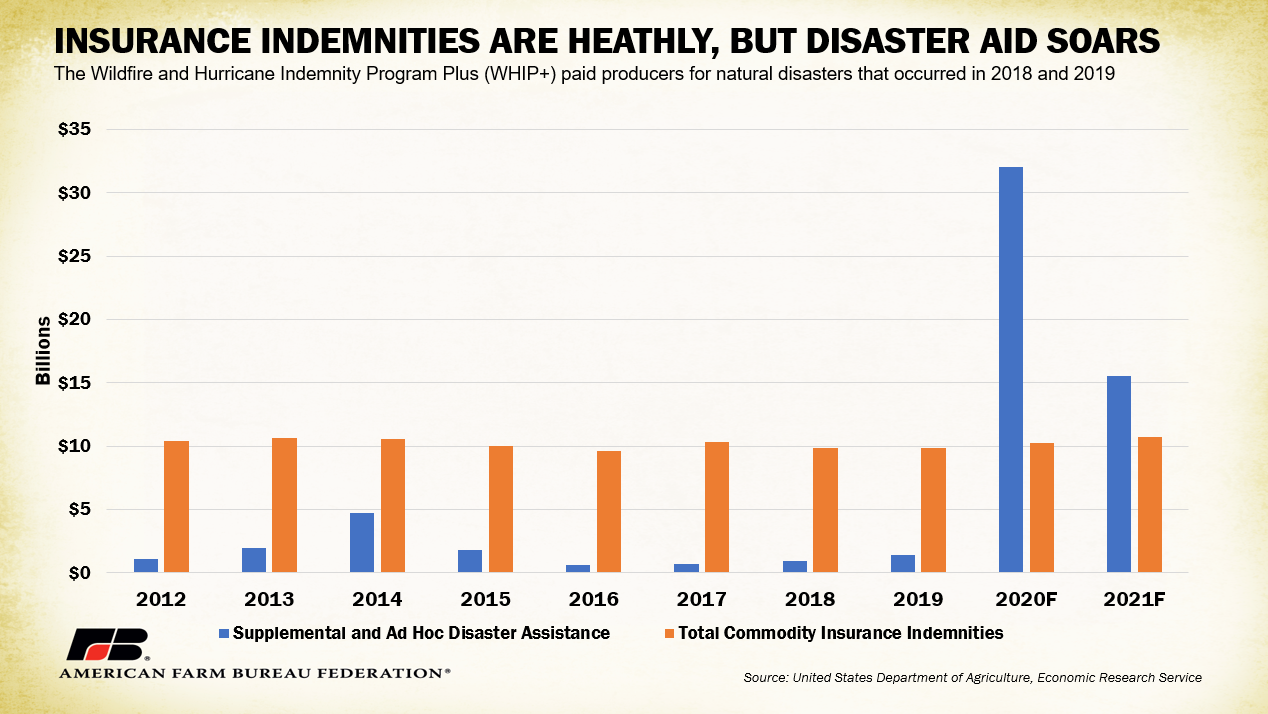2020 Disasters Reveal Gaps in Ad Hoc Aid Legislation
TOPICS
Wildfires
photo credit: Alabama Farmers Federation, Used with Permission
Daniel Munch
Economist
This is part two of AFBF’s Market Intel series highlighting disaster-related losses and corresponding policy hurdles farmers and ranchers faced in 2020. This article discusses the gaps and challenges in previous disaster aid legislation, particularly WHIP+, that have left some producers unsupported when disaster strikes.
In part one of this Market Intel series, AFBF presented its crop and rangeland damage estimations associated with 2020 natural disasters, which showed that farmers and ranchers faced over $6.5 billion in losses, over $3.6 billion, or 55%, of which was not covered by existing Risk Management Agency (RMA) programs. In 2018 and 2019, crop losses associated with qualifying weather disasters were partially mitigated by the Wildfire and Hurricane Indemnity Program Plus (WHIP+), a disaster assistance program with origins in the 2017 WHIP, which provided financial assistance to producers with disaster-related production losses on both insured and non-insured crops (Reviewing WHIP+ and Other Disaster Assistance Programs). WHIP+ has yet to be extended to cover unaccounted-for losses from 2020 disasters, leaving thousands of operations on their own to fully recover. AFBF recognizes the current efforts by Congress, in particular the House Agriculture Committee, to adjust and extend WHIP+. This Market Intel discusses shortcomings in previous iterations of the WHIP+ program in providing support to impacted farm and ranch families.
Supplemental and ad hoc programs designed to assist farmers and ranchers were particularly important in 2020 to counter impacts of the COVID-19 pandemic. With additional billions in losses related to weather and climate events, disaster aid for 2020 and 2021 is expected to drastically outpace total commodity insurance indemnity payouts.

Traditionally, federal crop insurance programs are the preferred mechanism for managing risk associated with weather-related disasters for most agricultural products. These policies provide protection from yield losses, increased feeding costs and revenue declines. Unanticipated disaster situations like the COVID-19 pandemic or large-scale weather events pose the optimal test for these programs, designed to provide targeted risk support under more probable and common loss conditions. Losses that occur outside the scope of these conditions and the specified terms of a policy complicate farmers’ ability to qualify for indemnity payments.
Qualifying weather events and related conditions
Under WHIP+, qualifying disaster events were a named hurricane, D3 (extreme) and D4 (exceptional) drought, excessive moisture, flooding, snowstorm, tornado, typhoon, volcanic activity, or a wildfire that occurred in 2018 or 2019 calendar years. Related conditions or conditions that occurred as a result and concurrently of the aforementioned weather events, such as heat, excessive wind and smoke, were also eligible.
Ineligible conditions
The WHIP+ handbook clearly states associated conditions not related to a qualifying weather disaster would not be eligible. For instance, “A tropical storm intensifies to become a named hurricane. The named hurricane’s path later becomes a tropical storm and a tropical depression. Only losses from the named hurricane and the subsequent tropical storm and subsequent tropical depression would be eligible.” In other words, losses from the preliminary tropical storm are not eligible. Another example: “A wildfire occurred in September. Subsequent rains caused a mudslide in November which destroyed the crop. The mudslide is not a related condition of the wildfire and therefore the loss is not eligible.” Wildfires notoriously destroy vegetation that help hold soil in place and often lead to mudslides and debris flow events. Both examples show how program qualifiers leave some conditions associated with major weather events uncovered.
Beyond tropical depressions, other storm types such as derechos, D2 (severe) drought and hailstorms are not explicitly listed as qualifying weather disasters under WHIP+. Increased soil salinity due to flooding on the Gulf Coast was also a culprit for agricultural damages and not explicitly protected. Furthermore, other types of losses, such as losses beyond the applicable crop year, were ineligible, which limits assistance for multi-year crops. Losses due to smoke taint, important to grape and wine producers impacted by wildfires, were also ineligible.
In an informal survey of state Farm Bureaus, AFBF gathered additional information about WHIP+’s shortcomings from the perspective of farmers and ranchers. A primary complaint was how long it took for farmers to receive their payments (a result linked to the retroactive nature of the program). For context, it was not until June 15, 2021, that producers began receiving 40% (on top of a previous 50%) of their calculated WHIP+ payments for 2019 losses. This means farmers and ranchers may have waited over two years to receive 90% of their calculated payments. Relatedly, members were concerned about the limited timeframe of the program, expressing preference for a more streamlined and consistent structure over more than one or two years. Others were frustrated with how often program requirements change, with some farmers stating they spent hours preparing documentation to submit an application for WHIP+ and or the Quality Loss Adjustment (QLA) Program only to be found ineligible under updated requirements.
As showcased in the first Market Intel in this series, some crop types, such as crops intended for grazing (rangeland), are not currently eligible for payments under the prior framework of WHIP+. Members from Western states, especially, reported inability to benefit from WHIP+ as a large percentage of their counties impacted by drought are rangeland. Additionally, concern persists about irrigated rangeland being ignored. Farmers and ranchers point out that even though irrigated rangeland, in classification, has access to water, persisting drought impacts availability of surface water deliveries. In other words, being called “irrigated” doesn’t necessarily translate to having current water access.
Support for the timber and nursery industries was also requested across the board. A Louisiana State University study of timber impacts from 2020 hurricanes Delta and Laura estimated over $1.3 billion in Louisiana losses alone. Given the long-term investment nature of trees as crops, lumber stakeholders face a long road to recovery. Regarding nurseries, crops exposed to the elements when greenhouses are breached or damaged during storms often must be destroyed as they fail mandated quarantine requirements. Others are exposed to molds, parasites and diseases, causing widespread die-offs.
Additional issues producers brought up surrounding WHIP+ included a lack of support for contiguous county losses and double-cropping losses and a reliance on payment (unharvested) factors based on underlying data that is not kept up to date. If not incorporated into the central WHIP+, producers also hope for continued eligibility for harvested commodities through the on-farm loss storage program. Similarly, though concerned with the program’s qualifying requirements, there was widespread support for a continuation of QLA for producers who suffer quality losses from natural disasters.
Conclusion
With 22 separate billion-dollar weather events, 2020 shattered a previous annual record of 16, according to the National Oceanic and Atmospheric Administration. From massive hurricanes on the Gulf Coast to fast spreading wildfires in the West, almost all agricultural product types were impacted. Given the diversity of American agriculture, the severity of 2020’s disasters exposed cracks in ad hoc disaster assistance programs such as WHIP+, leaving many producers on the sidelines. Taking a comprehensive look into the ground level implementation and challenges faced by intended beneficiaries can help improve the effectiveness of disaster assistance programs, providing for a more stable farm economy and secure domestic food supply.
Top Issues
VIEW ALL